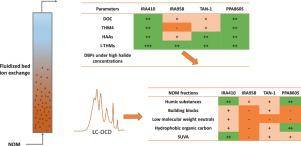Journal of Environmental Chemical Engineering ( IF 7.7 ) Pub Date : 2020-10-17 , DOI: 10.1016/j.jece.2020.104602 Henry MacKeown , Junias Adusei Gyamfi , Morgan Delaporte , Klaas Vital Kaat Marnix Schoutteten , Liesbeth Verdickt , Baghdad Ouddane , Justine Criquet

|
The removal of dissolved organic carbon (DOC) is a key factor in the control of disinfection by-product (DBP) formation in drinking water. Ion exchange process deals with the removal of naturally negatively charged organic matter. A fluidized bed column test has been chosen to test in parallel the efficiency of 4 different anionic exchange resins (Purolite PPA860S, Dowex TAN-1, Amberlite IRA-958 and IRA-410) in terms of DOC fraction removal and related DBP formation reduction. IRA-410 was shown to be the best performing resin in terms of DOC and DBP formation potential reduction followed by PPA860S. These resins removed respectively 41 and 37% of DOC, with humic substances as the main target of the two resins (68 and 72% reduction, respectively, based on size exclusion chromatography with an organic carbon detector). The UV absorbance was reduced in a higher proportion than the DOC demonstrating a preference of the resins for the relatively hydrophobic compounds. The reduction in trihalomethane and haloacetic acid formation was higher than the DOC removal for IRA-410 and PPA860S (53 and 59%, respectively); whereas IRA-958 on the other hand showed a lower reduction in DBP formation potential than its DOC removal. All the resins showed a much higher reduction of iodinated trihalomethanes formation potential (66 to 96% reduction compared to raw water) due to the removals of iodide in addition of organic precursors. However, in a context of increasing halide concentrations, the different resins showed a reduction of their efficiency to control the formation of DBPs.
中文翻译:

用离子交换树脂去除消毒副产物前体
溶解有机碳(DOC)的去除是控制饮用水中消毒副产物(DBP)形成的关键因素。离子交换过程涉及去除天然带负电的有机物。选择了流化床柱测试来并行测试4种不同的阴离子交换树脂(Purolite PPA860S,Dowex TAN-1,Amberlite IRA-958和IRA-410)在DOC去除率和相关DBP形成减少方面的效率。就减少DOC和DBP形成潜力而言,IRA-410被证明是性能最好的树脂,其次是PPA860S。这些树脂分别去除了41%和37%的DOC,其中腐殖质是这两种树脂的主要目标(基于使用有机碳检测器的尺寸排阻色谱法,分别减少了68%和72%)。与DOC相比,UV吸收率降低的比例更高,这表明树脂更偏爱相对疏水的化合物。三卤代甲烷和卤代乙酸形成的减少高于IRA-410和PPA860S的DOC去除(分别为53%和59%);相反,IRA-958的DBP形成潜力降低幅度要比其DOC去除幅度低。由于除有机前体外还除去了碘化物,所有树脂均显示出更高的碘化三卤甲烷生成潜力的降低(与原水相比降低了66%至96%)。但是,在卤化物浓度增加的情况下,不同的树脂显示出控制DBP形成的效率降低。



























 京公网安备 11010802027423号
京公网安备 11010802027423号